Thank you very much for visiting Gunter's Space Page. I hope that this site is useful and informative for you.
If you appreciate the information provided on this site, please consider supporting my work by making a simple and secure donation via PayPal. Please help to run the website and keep everything free of charge. Thank you very much.
Nimbus 7

Nimbus 7 [NASA]
The Nimbus 7 research-and-development satellite served as a stabilized, earth-oriented platform for the testing of advanced systems for sensing and collecting data in the pollution, oceanographic and meteorological disciplines. The polar-orbiting spacecraft consisted of three major structures:
- a hollow torus-shaped sensor mount,
- solar paddles, and
- a control housing unit that was connected to the sensor mount by a tripod truss structure.
Configured somewhat like an ocean buoy, Nimbus 7 was nearly 3.04 m tall, 1.52 m in diameter at the base, and about 3.96 m wide with solar paddles extended. The sensor mount that formed the satellite base housed the electronics equipment and battery modules. The lower surface of the torus provided mounting space for sensors and antennas. A box-beam structure mounted within the center of the torus provided support for the larger sensor experiments. Mounted on the control housing unit, which was located on top of the spacecraft, were sun sensors, horizon scanners, and a command antenna. The spacecraft spin axis was pointed at the earth. An advanced attitude-control system permitted the spacecraft's orientation to be controlled to within plus or minus 1 deg in all three axes (pitch, roll, and yaw). Eight experiments were selected:
- limb infrared monitoring of the stratosphere (LIMS),
- stratospheric and mesopheric sounder (SAMS),
- coastal-zone color scanner (CZCS),
- stratospheric aerosol measurement II (SAM II),
- earth radiation budget (ERB),
- scanning multichannel microwave radiometer (SMMR),
- solar backscatter UV and total ozone mapping spectrometer (SBUV/TOMS), and
- temperature-humidity infrared radiometer (THIR).
These sensors were capable of observing several parameters at and below the mesospheric levels.
| Nation: | USA |
|---|---|
| Type / Application: | Meteorology, experimental |
| Operator: | NASA, NOAA |
| Contractors: | RCA Astrospace |
| Equipment: | LIMS; SAMS, CZCS, SAM II, ERB, SMMR, SBUV/TOMS, THIR |
| Configuration: | Nimbus Bus |
| Propulsion: | ? |
| Power: | 2 deployable solar arrays, batteries |
| Lifetime: | |
| Mass: | 832 kg |
| Orbit: | 941 km × 954 km, 99.15° |
| Satellite | COSPAR | Date | LS | Launch Vehicle | Remarks | |
|---|---|---|---|---|---|---|
| Nimbus 7 (Nimbus G) | 1978-098A | 24.10.1978 | Va SLC-2W | Delta-2910 | with CAMEO |
References:
- NSSDC Master Catalog: Nimbus 7
